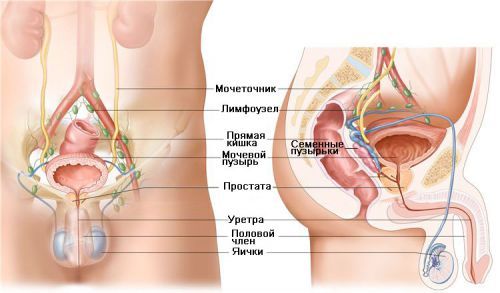Detection of blood in urine in medical terms is called hematuria. Sometimes detected only by microscopy of sediment over a larger number of red blood cells. Much more serious to treat a situation when the bright blood comes out with urine, there are traces of clots or streaks on the toilet.
These signs are referred to, respectively by microhematuria and gross hematuria. Normal allowed a few red blood cells in field of view microscopy of urine sediment. There are also physiological causes of blood in urine.
To eliminate the influence of pathological changes of the research on the subject difficult the detection of red blood cells, but also to clarify the question of which Department of the urinary system they belong to. This helps to pinpoint the specific disease, the nature of the lesion.
Pathways of blood in the urine
Blood and urine (urine) is a natural biological liquid of the organism. They perform important functions and are not able to mix.
Barriers are:
- blood vessels of different caliber;
- the membrane of the nephron in the renal glomeruli;
- the renal capsule and the muscular coat of the ureters and bladder.
To solve why in the urine appeared blood cells, it is necessary to check the status of protective mechanisms.

5 possible options violations:
- The destruction of the membrane for filtering and delay of red blood cells in the renal glomeruli (nephrons) in the formation of primary urine. This process is actively going on in all types of inflammation of the parenchyma (nephritis), moves with the cups and pelvis during the severe stage of pyelonephritis.
- The loss of vascular wall elasticity and increasing its permeability. Feeding artery and the venous network, accompany all the urinary organs, it is delivered is necessary for the cells of the material are carried away waste toxins. The involvement of vessel inflammation leads to loosening of the tissue and increased permeability. Even more pronounced failure can be the growing tumors, trauma.
- General congestion of cardiac decompensation activities necessarily affect the veins of the pelvic organs and kidneys. Phlebitis, thrombosis increased pressure inside the veins and contribute to the release of blood in urine.
- Possible mechanical compression of the urinary organs and vessels, for example, a growing tumor, an enlarged renal pelvis in hydronephrosis.
- Systemic lesions of the capillaries in hemorrhagic diathesis, fevers, diseases of the blood causing local destruction of glomerular filtration mechanisms, increase the permeability.
That means blood in the urine, have to figure out in each case individually.
Reliable data can only be considered obtained by the study of properly collected urine
Causes of microscopic hematuria that does not depend on pathology
The increase in the number of erythrocytes in the sediment after urine collection in the background:
- overheating in the steam bath;
- prolonged exposure to the sun in the heat;
- suffering stress;
- drinking alcoholic beverages, eating spicy and salty dishes.
Blood in the urine after exercise in the form of microscopic hematuria occurs temporarily and ceases after the holiday. If the color of urine remains bloody for a long period, it is already talking about possible pathology.
The diagnosis has the value of the disappearance of hematuria in the supine position and resume in the vertical position of the body. Such a distinctive symptom indicates a dropped kidney (nephroptosis) and its abnormal mobility.
It should be particularly emphasized the importance of getting blood in urine from bleeding in women, from the genitals:
- during menstruation;
- from the eroded surface of the cervix;
- when fibromatous changes with uterine bleeding;
- in the postpartum period.
In men, blood in the urine is often associated with prostatitis, prostate adenoma.
When there are erroneous suspicion of hematuria?
Some patients scares reddish urine. They are taking it for the mandatory admixture of blood. However, this symptom must be distinguished from the effect on the urine color food coloring.

The most vivid coloration is obtained after consumption of beets, carrots, blueberries
Proved the influence of such medications, such as vitamin b12, ascorbic acid, Analgin.
Transcript analysis, a comparison of the number of red blood cells with other elements of the urine sediment (leukocytes, protein, cylinders, bacteria, mucus, salts) gives you the opportunity to find out the specific cause of blood in the urine.
What pathological changes cause hematuria?
To pathology refers the presence of blood in the urine. One symptom cannot make a correct diagnosis. Medical history, inspection of other clinical signs, the results of the survey help to find out the true cause and to appoint optimum treatment.
Diseases of the urinary hematuria is possible with:
- acute and chronic form of glomerulonephritis;
- severe form of cystitis;
- kidney stone diseases;
- hydronephrosis;
- tuberculosis of the kidney;
- tumors of the kidney and bladder.

Less frequent symptom is observed in urethritis, pyelonephritis.
In this case, the blood in the gap is more distributed in the layers of fat tissue in the pelvis it is not, then there will be hematuria
Traumatic injuries of the pelvis and abdomen:
- strikes;
- injuries;
- the gap;
- compression.
They are accompanied from microscopic hematuria to severe bleeding during urination in connection with the gap. In hospitals surgical trauma are the consequences of the installation in the urethral canal of the catheter, blood in the urine in this case is the result of a breach of mucosal integrity and small vessels.
Similar results leading procedure begerovaya of the urethra in men.
Blood in the urine after the operation requires specification of the attending physician the degree of influence of surgical operation on the urinary organs.
- When you remove the kidney or partial resection of the left temporal thin tube in the cavity of the pelvis, which is the outflow of urine and blood. Through it the patient is lavage of the kidney, are introduced drugs.
- If the operation was not carried out on the urinary organs, the blood in the urine means to the patient the occurrence of complications.
Professional riders injury is the damage to the perineum and bulb of the urethra with subsequent hematuria.
Poisoning from toxic substances, accompanied by renal filtration unit, inability to urinate independently, highlighting the clotted blood from the urethra.
Fever in any disease, and infectious hemorrhagic renal capillaries are observed:
- defeat the toxic products of protein breakdown and bacteria;
- hemorrhagic kapilliarotoxicos.
In cases of cardiac decompensation with heart diseases, hypertension, previous myocardial infarction plays a major role in venous stasis and increased pressure in the system the renal vein.
Blood disorder with a reduced clotting (thrombocytopenia, hemophilia), accompanied by impaired renal function and hematuria to end-stage, as well as the receipt of fibrin that forms blood clots in the urine.
Erythrocytes may appear in the urine of the patient while trying to treat him sulfa drugs, methenamine, high doses of vitamin C, an overdose of anticoagulants. These funds have a toxic action on the kidneys of susceptible persons. Patients should be warned about the monitoring of urine, if prescribed these medications.
What symptoms accompany hematuria?
The most difficult diagnosis is asymptomatic gross hematuria. It occurs suddenly, the patient feels no pain, but notice a clear blood in the urine. In such cases, suspected tumor of the kidney or bladder. This disease, unfortunately, long runs secretly.

Turning to the doctor want to do not only analysis of blood and urine, but also to conduct various tests. Timely initiation of treatment depends on the health and life of the patient. If the patient complains that it is “painful to write”, and in the urine found blood clots, there is a suspicion of lesions of the bladder as the source of bleeding.
Clots can form when the inflammation (cystitis) with ulceration of the cervix area, a large stone or tumor
Sometimes clots have the form of “worms”. They are formed in the ureters or the pelvis. Receives blood from the parenchyma of the kidney. Often such bleeding is preceded by an attack of renal colic due to movement of stone in the pelvis or ureter.
To decrypt data analysis can not on their own.
The doctor in the diagnosis takes into account symptoms such as:
- pain when urinating;
- more frequent urination;
- the delay of urine;
- back pain and in the abdomen;
- night urination;
- the increase in body temperature;
- hypertension.
These symptoms confirm the opinion that the pathology of the urinary or deny it.
More about symptoms of blood in urine in children, click here.
What States need to distinguish between true hematuria?
In the differential diagnosis of urologists are faced with the need to distinguish between true hematuria from similar conditions.
These include:
- urethrorrhea – the so-called flow of blood drops from the urethral orifice spontaneously without the act of urination, occurs as a complication of the procedure, cystoscopy, catheterization of the bladder, begerovaya;
- myoglobinuria is one of the manifestations of the syndrome of prolonged crushing, muscle myoglobin increases in your blood in case of massive destruction of muscle tissue that causes the blockage of kidney filtering, so the victims from the rubble of buildings, attacks detected by the red urine, these patients required urgent hemodialysis.
When destruction of red blood cells (hemolyzing action of toxic substances, and hemolytic crises) in the blood is hemoglobin and the red blood cells while in the urine sediment no.
Color of urine becomes very dark.

Observed on the background:
- shock from transfusion of incompatible group and rhesus of blood;
- burns 3-4 degree;
- hemolytic anemia;
- severe stage of typhus, diphtheria, scarlet fever.
Dark urine – an indicator of hematuria
Is it possible to conduct diagnosis with the help of Express methods?
To understand the human condition, seeing her blood in the urine. Waiting for the results of the survey is carried heavily. There are proposed methods of Express analysis with the help of special test strips. The statement requires that the strip was immersed in a container of urine, was then dried and compared with standard calibration color scale was assessed in terms of the availability of hematuria.
In the practice of urology this test is not considered sensitive enough:
- can not accurately reveal microhematuria;
- you can’t distinguish hematuria from gemoglobinurii.
So conduct your own tests at home is not recommended. It is better to collect your urine in accordance with the rules and get enough informative conclusion.
Which gives the definition of the red blood cells?
One identifying erythrocytes in the urine is insufficient to answer the question about the source of bleeding, level of lesion urinary tract. To do this, the technician must determine the type of change of erythrocyte cells.
By urine sediment microscopy reveals 2 types of erythrocytes:
- Unchanged appear as rounded cells with a concave inside the middle, filled with hemoglobin, are reddish (the same cells are present in the blood). Come from the kidneys or bladder in the absence of any urinary retention.
- Altered or leached – formed in the event of a prolonged stay in the urine, look wrinkled, and rings, lose hemoglobin. Such changes are possible in nephrolithiasis, tumor, obstructing the ureter or bladder neck, abnormalities of the ureters and kidneys, hydronephrosis.
A variant of the norm are considered to be leached erythrocytes in the urine of people with a primary meat type of food. Restriction of vegetables and fruits leads to the lack of alkaline reserve in the body. To maintain the balance of alkali “extracted” from their own cells.
Detection of impurities in the urine, like blood, should alert the patient and lead to awareness of the need for a full examination. However, note that laboratory analysis is not considered by doctors as the main symptom of a particular disease.



